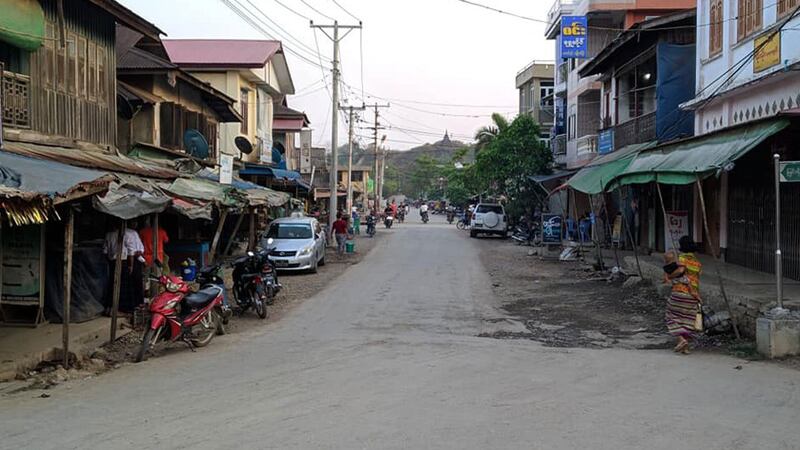The Arakan Army has attacked the Myanmar junta's military in the western state of Rakhine, ending a ceasefire brokered one year ago on humanitarian grounds, residents told Radio Free Asia. Five civilians were killed and nearly 20 were injured in the fighting, they said.
The offensive in Rakhine state coincides with the Arakan Army's participation in Operation 1027 – named after the Oct. 27 military actions that started it – as part of the Three Brotherhood Alliance with two other armed ethnic groups against the military in Shan state in the north.
Monday’s offensive in Rakhine included attacks on border guard police outposts and convoys of the military council in Rathedaung and Minbya townships, and these attacks have led to armed clashes, residents said.
Arakan Army soldiers fired at two border police outposts in Done Paik and Chein Khar Li in Rathedaung township, at around 5 a.m., a resident who requested anonymity for security reasons told RFA Burmese.
“We heard gun fire early this morning,” she said. “Then we fled to the monastery where we stayed one hour before leaving for Sin Paik village amid the armed clashes. No one is at the village.”
Soon after the attack, the military’s 536th Light Infantry Battalion of the military council, stationed in Rathedaung township, fired artillery shells continuously, she said.
Landmines
The Arakan Army also laid landmines in the road, which stopped two trucks that were part of a military convoy near Hpar Hpyo village on the Sittwe-Yangon highway after the convoy left the No. 9 Central Command in Mingya township, and then the fighting erupted, a resident there told RFA on condition of anonymity to speak freely.
“Two trucks of the convoy fully loaded with soldiers and supplies left No. 9 Central Command,” he said. “The fighting took place near Hpar Hpyo village. Some people from the paddy fields saw a truck catch fire. These people fled and did not see the situation of another truck.”
Military troops stationed at the Kyeintaung Pagoda hill in Minbya township fired artillery shells into the area of conflict. One of the stray shells injured Aung Thein Phyu, a 50-year-old man, as he was collecting paddy seeds in the field.

As the news spread about the attacks, 26 officers in the Ah Pauk Wa police outpost in Kyauktaw township surrendered to the Arakan Army, and they were taken into custody, residents said.
In the city of Mrauk-U in northern Rakhine, armed clashes flared in the morning, killing one civilian and injuring at least four more, a resident there told RFA.
“When I arrived at the scene of the incident, many bullet shells were found on the seats of a car,” the resident said. “A person was dead on the seat. But I did not clearly see the body at the front seat of the car which was in the bushes. A car from a local free funeral service gathered the body.”
Neither the Arakan Army nor the military council has made an official statement on Monday’s attack. Hla Thein, a spokesperson of the junta-aligned Rakhine state government, also didn’t respond to phone calls from RFA for details.
The fighting that started Monday in Rakhine state was related to Operation 1027 in northern Shan state, Pe Than, a Rakhine politician told RFA.
“Armed clashes are expected to occur in [Rakhine] state,” he said. “The area of conflict will depend on the Arakan Army, and the fighting will last longer.”
He also said that since war has returned to Rakhine state, the civilians need to be cautious about possible military council attacks.
Monday’s attacks will result in a resumption of conflict in Rakhine, Richard Horsey, the International Crisis Group’s senior Myanmar adviser, told RFA.
“If combat persists, it will open a significant new front for the regime, which is already overstretched with fighting including on its eastern border with China,” Horsey said. “Facing major difficulties in northern Shan state alongside attacks from anti-regime forces probing for military weaknesses elsewhere, it will be hard for the regime to focus their efforts across all fronts.”
Residents said that following the attacks, the junta immediately blocked the Sittwe-Yangon highway, which is the only motorway in northern Rakhine, and all of the waterways.
Martial law in Shan state
In Shan state, the junta on Sunday declared martial law in eight townships – Kun Long, Kutkai, Namkham, Muse, Lashio, Hseni, Laukkai and Konkyan – all of which are under varying degrees of control by the Three Brotherhood Alliance, which consists of the Arakan Army, the Ta'ang National Liberation Army and the Myanmar National Democratic Alliance Army.
Than Soe Naing, a political analyst, told RFA that the military imposed the declaration to suggest they still have power in these areas, especially in the cities where major military outposts are located in Hseni and Namkham.
“The major bridge has been broken in Hsenwi. The whole town has been occupied. However, the military forces are still stationed at their base in Hsenwi,” he said. “The declaration of martial law in this area is to insist on the existence of their power there. The areas they have totally lost are not included in the imposition of martial law. Actually, all of northern Shan state has been surrounded by the resistance forces.”
A spokesperson from the Ta’ang National Liberation Army who requested anonymity for security reasons told RFA that the martial law will not be effective in these townships.
“Since the military coup, the junta has declared martial law many times, although this is the first time in northern Shan state,” he said. “It is just the normal strategy for them.”
RFA attempted to contact junta spokesman Maj. Gen Zaw Min Tun for comment on the order of martial law, but he could not be reached.
Translated by Aung Naing. Edited by Eugene Whong and Malcolm Foster.
